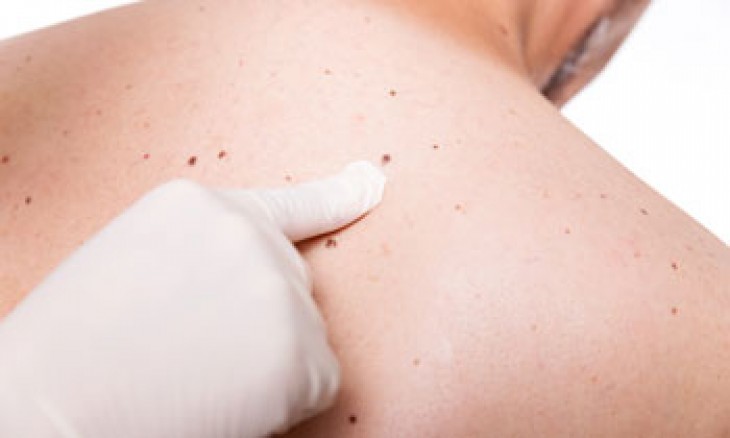
Cancer Care
The ABCDEs of skin cancer
It’s not breast cancer. It’s not prostate or colon cancer either. The most common form of cancer is skin cancer. While protecting your skin may not always be a priority, it should be as the number of skin cancer cases is on the rise with 3.3 million American diagnosed every year.
Dermatologist Joseph Andrews, MD notes that oftentimes skin cancer is not perceived to be a potentially serious condition. Consequently, patients may not monitor changes in moles or have concerns about new skin lesions that may appear. “Skin cancer can be cured if caught early, but may be devastating if left unattended,” Dr. Andrews said. “Patients could lose part of their nose or even die from skin cancer. These growths all start as small lesions and, if identified and treated early, are completely preventable.”
The three main skin cancers are melanoma, basal cell carcinoma and squamous cell carcinoma. Melanomas are commonly found on the facial cheeks or back in men, and on the lower extremities in women. Basal cell carcinomas are most common on sun-exposed areas such as the head and neck. Squamous cell carcinomas commonly appear on sun-exposed areas of the body such as the face, ears, neck, and the back of the hands.
Dr. Andrews said education plays a key part in preventing these cancers, noting the ABCDEs of skin cancer can help a patient determine whether or not they need to see a physician.
ASYMMETRY: If you were to cut the lesion in half, the two halves should look like mirror images. If they do not, the lesion is suspicious.
BORDER IRREGULARITY: The edges are jagged or fuzzy. Normal lesions have a distinct, well circumscribed border.
COLOR: The color pigmentation is uneven with shades of tan, brown, and black present. Normal lesions should be uniformly colored.
DIAMETER: The mole is greater than six millimeters in diameter and about the size of an eraser on a pencil.
EVOLUTION: Monitor changes in mole size, shape, and color, or if you have symptoms such as itching, burning or bleeding over time.
If any of these take place, Dr. Andrews suggests making an appointment with your physician or a dermatologist. “The most common precancerous lesion is known as an actinic keratosis. These are scaly growths caused by sun damage,” Dr. Andrews said. “Finding and treating these early is key. Left unchecked, actinic keratosis can turn into squamous cell carcinoma.”
Most at risk for skin cancer are individuals who work or spend a lot of time outside, individuals with fair skin and those who go to tanning beds. A common misconception is that tanning isn’t bad for your skin. “You must protect your skin,” Dr. Andrews. “It’s important to check yourself once a month and keep an eye on suspicious spots. If you notice anything suspicious, call your physician immediately.”
Call 1-866-BayDocs (229-3627) to be matched with a Bayhealth doctor.
Dermatologist Joseph Andrews, MD notes that oftentimes skin cancer is not perceived to be a potentially serious condition. Consequently, patients may not monitor changes in moles or have concerns about new skin lesions that may appear. “Skin cancer can be cured if caught early, but may be devastating if left unattended,” Dr. Andrews said. “Patients could lose part of their nose or even die from skin cancer. These growths all start as small lesions and, if identified and treated early, are completely preventable.”
The three main skin cancers are melanoma, basal cell carcinoma and squamous cell carcinoma. Melanomas are commonly found on the facial cheeks or back in men, and on the lower extremities in women. Basal cell carcinomas are most common on sun-exposed areas such as the head and neck. Squamous cell carcinomas commonly appear on sun-exposed areas of the body such as the face, ears, neck, and the back of the hands.
Dr. Andrews said education plays a key part in preventing these cancers, noting the ABCDEs of skin cancer can help a patient determine whether or not they need to see a physician.
ASYMMETRY: If you were to cut the lesion in half, the two halves should look like mirror images. If they do not, the lesion is suspicious.
BORDER IRREGULARITY: The edges are jagged or fuzzy. Normal lesions have a distinct, well circumscribed border.
COLOR: The color pigmentation is uneven with shades of tan, brown, and black present. Normal lesions should be uniformly colored.
DIAMETER: The mole is greater than six millimeters in diameter and about the size of an eraser on a pencil.
EVOLUTION: Monitor changes in mole size, shape, and color, or if you have symptoms such as itching, burning or bleeding over time.
If any of these take place, Dr. Andrews suggests making an appointment with your physician or a dermatologist. “The most common precancerous lesion is known as an actinic keratosis. These are scaly growths caused by sun damage,” Dr. Andrews said. “Finding and treating these early is key. Left unchecked, actinic keratosis can turn into squamous cell carcinoma.”
Most at risk for skin cancer are individuals who work or spend a lot of time outside, individuals with fair skin and those who go to tanning beds. A common misconception is that tanning isn’t bad for your skin. “You must protect your skin,” Dr. Andrews. “It’s important to check yourself once a month and keep an eye on suspicious spots. If you notice anything suspicious, call your physician immediately.”
Call 1-866-BayDocs (229-3627) to be matched with a Bayhealth doctor.
